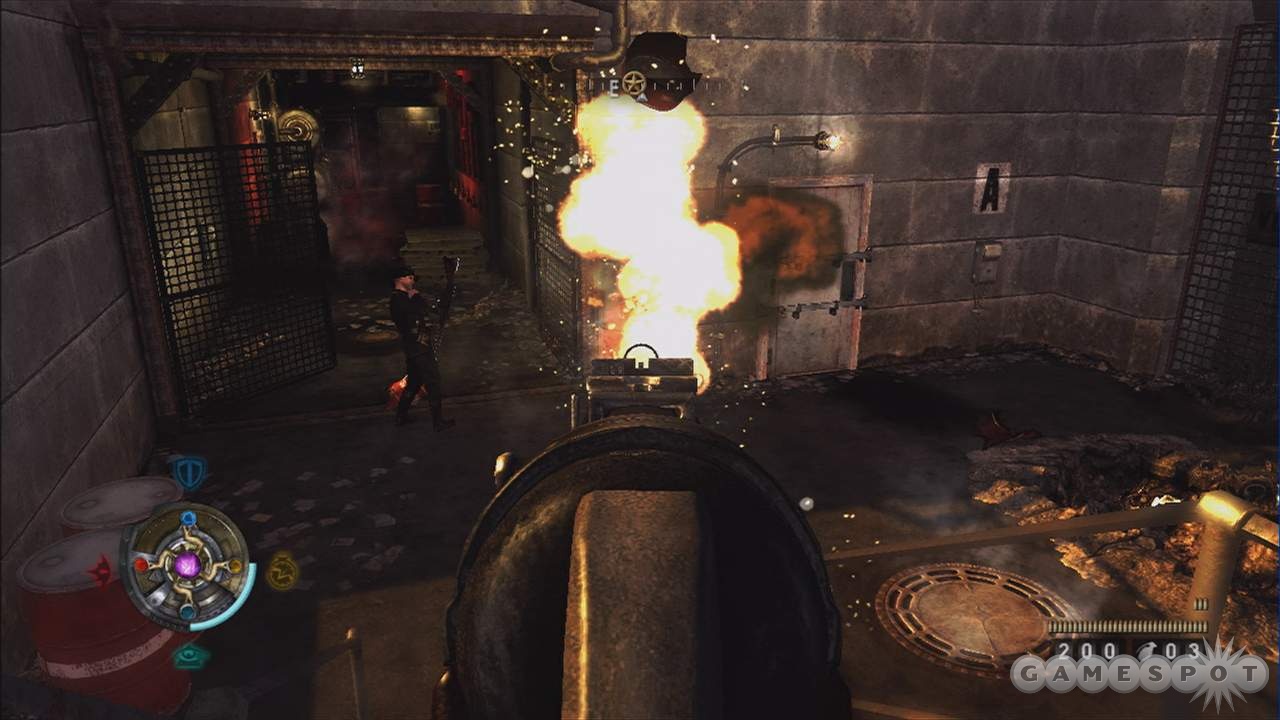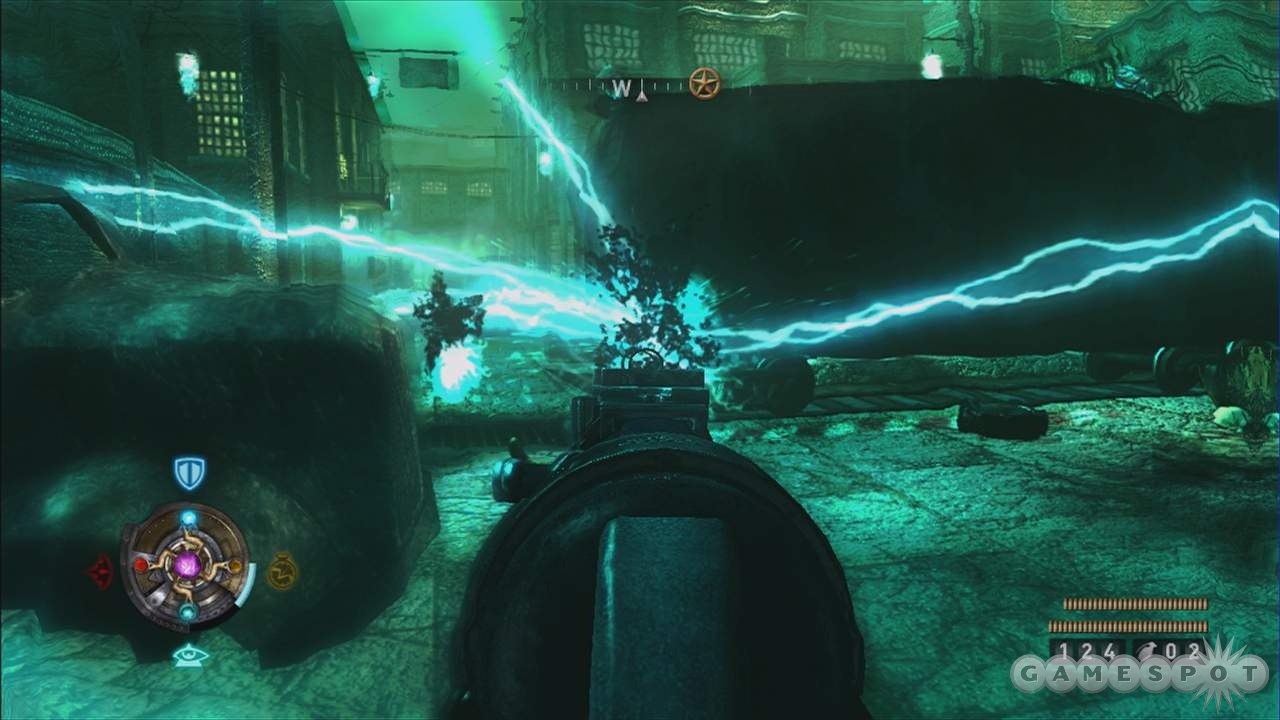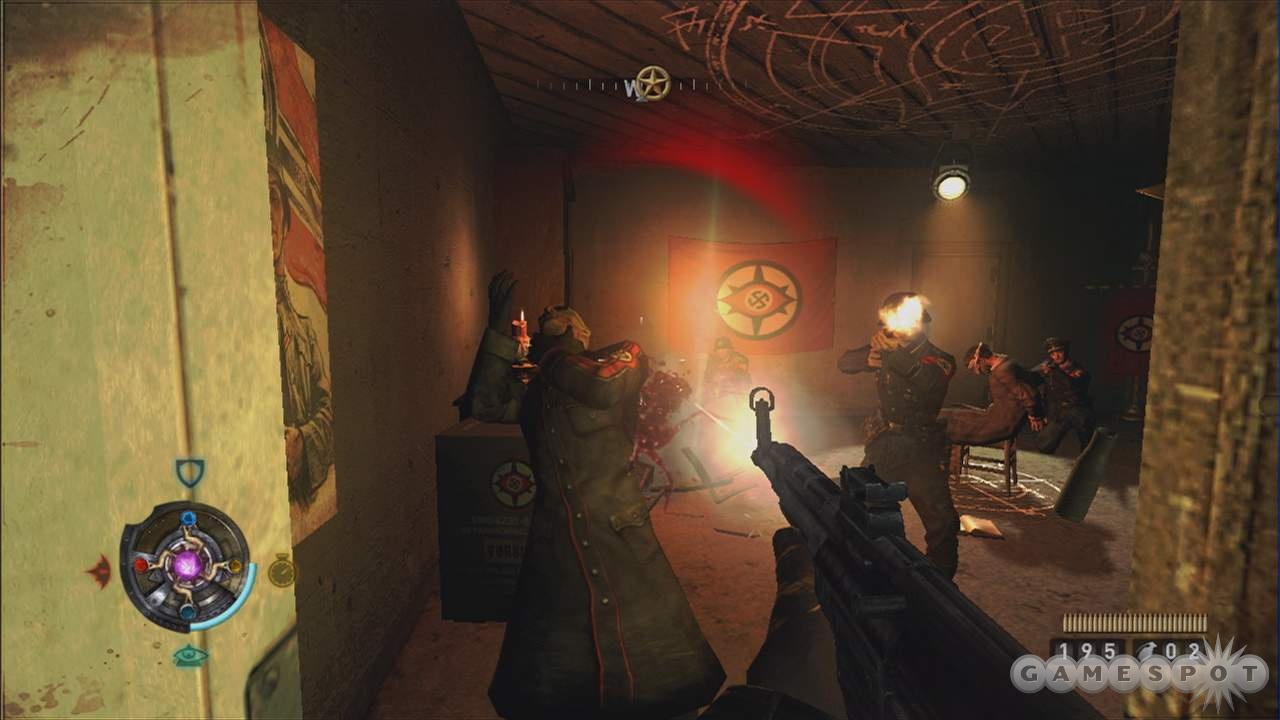Most modern first-person shooters are so very serious. They feature a whole lot of brown environments and gruff characters, but never have enough archways into alternate universes. Well, if you're in the mood for an FPS with a glint in its figurative eye, Wolfenstein is a good way to stave off the forces of evil without the in-game grumpiness that usually accompanies such endeavors. This sequel to 2001's Return to Castle Wolfenstein is a worthy addition to the series and a fun romp in its own right. The game won't set your world on fire; it occasionally stops feeling old-fashioned and starts feeling just plain old, and a number of flaws are woven throughout the gameplay's very fabric. Some awesome boss fights and memorable combat sequences prevent Wolfenstein from falling into a rut, however. Besides, you're not just fighting Nazis--you're fighting magic Nazis that conjure force fields and fly around with jetpacks.
The setup for this historical/sci-fi mash-up is typical Wolfenstein whimsy, shouldered by the ever-capable B.J. Blaskowicz. This returning hero has spilled his share of Nazi blood, so who better than B.J. to protect the residents of the city of Isenstadt (not to be confused with the Austrian city of Eisenstadt) from the ongoing onslaught? Isenstadt is the headquarters of several resistance groups that seeks to wrest the secrets of the supernatural from the hands of the Schutzstaffel. It seems the Nazis are up to their old tricks, this time harnessing the powers of a mystical force called the Black Sun for the usual take-over-the-world kind of evil. If you know the series, you know not to expect much substance or surprise, though it's too bad there isn't more to draw you into this kitschy fiction. A lot of this has to do with the technology powering the game. Wolfenstein looks a bit aged; the prerendered cutscenes look overcompressed and facial animations are stiff. These second-rate assets, along with unenthusiastic voice acting, are distracting and make it hard to get invested in your fellow insurgents. Wolfenstein's story is a throwaway that boils down to a simple premise: Throw a bunch of Nazis into the occultist blender and see what cockamamy concoction pours out.
As it turns out, this concoction doesn't offer many surprises. Though you'll get tastes of role-playing elements and paranormal wizardry, Wolfenstein sticks to the trusty run-and-gun formula that has worked so well for shooters over the years. And it does it well, sending you into country farms, sprawling airfields, and secretive corridors to see how well you can fend off the soldiers and various anomalies it flings toward you. Your tools of destruction are solid. Traditional World War II weapons, such as the MP40 SMG and the Flammenwerfer, feel excellent, so even if you run out of ammo for the more powerful firearms, you'll never lament falling back to the simpler choices. But the better half of your arsenal is essentially snatched from an alternate reality. Of these options, you'll quickly grow fond of the Tesla gun, which fires electric streams in various directions at once, and the Leichenfaust 44, which is a heavy weapon that instantly vaporizes standard enemies. As you explore Isenstadt and complete missions, you'll earn money and find bags of coins. You can then spend these spoils on upgrades for your weapons, such as diminished recoil or greater damage. While some weapons are better in certain circumstances than others, there's really no weak banana in this bunch.
The action itself is rudimentary as far as first-person shooters go. There is no cover system to grapple with; you won't peek around corners, slink in the shadows, or pilot vehicles. You can, however, enter a parallel dimension called The Veil. When you activate The Veil, the world is shrouded in a shimmering cloak. In it, you can run faster, and enemies glisten, making them easier to target. Odd creatures called geists also float about, shocking nearby enemies if you shoot them down and even creating fearsome webs of electricity in tandem with neighboring geists. More importantly, entering The Veil lets you perform three potent powers: slow down time, surround yourself with a bulletproof shield, and empower your own bullets to do more damage and pierce paranormal force fields. You can also purchase upgrades for Veil powers just as you do for weapons. Eventually, you might be turning adjacent enemies into pillars of ash when you suppress the flow of time or deflecting bullets back toward your foes when in the safety of your shield.
Similar powers have appeared elsewhere; if you've played either Ubersoldier game, for example, it's hard to dismiss the similarities as mere coincidence. Yet contrived or not, you'll need to make frequent use of The Veil. Wolfenstein is challenging when you don't use it; in spite of his regenerating health, B.J. is rather fragile. The game often pits you against a healthy (or unhealthy, in this case) number of Nazi soldiers and ninja-speed sorcerers, so you'll need to stay on your toes and charge up your Veil energy reserves whenever you see an energy deposit's telltale shimmer. That doesn't mean your adversaries are very smart. Soldiers often won't react to a grenade thrown at their feet, don't always care when the Nazi standing right next to them gets shot, and generally seem unconcerned with preserving their own lives. The challenge comes from sheer numbers--and from time to time, it will come from cheap attacks that can lead to frustration. Cloaked sorcerers and fleet-footed vixens can sneak right up and kill you in a slash or two--an occurrence that can be hard to avoid if you fail to glimpse them by chance or miss the sound effects that signal their presence. Dealing with one-hit-kill surprises like that isn't much fun, and there are a few other sudden arrivals that are almost impossible to prepare for, such as rocket-spewing meanies flying about.
Nevertheless, Wolfenstein is a fun journey that more often than not shies away from that kind of unfair trial and error. The tension of combat culminates with several fantastic boss battles, each of which requires you to think on your toes and utilize Veil powers to the best of your ability. The final boss fight is the finest of them all--the kind of exciting and extended epic conflict that you rarely see in recent shooters. Your struggles against bosses, along with some terrific set piece battles, help energize the more predictable firefights that light up the streets of Isenstadt. In a very early scenario, for example, you'll discover that shooting the containers of blue goo will cause enemies near them to rise into the air as if immune to gravity. You'll fight your way across the room, sending Nazis into the air and filling them with lead as they flail helplessly (it's unclear why they won't use their weapons once airborne, but perhaps it's best not to ask). Other memorable sequences include an escape from an underground base on the brink of destruction and an assault on a sinister stronghold that is replete with Nazi flags fluttering in the wind. Even in the less intriguing battles, soldiers flail around when they catch on fire and headshots result in a gruesome spattering of blood. If you're looking for an exaggerated and occasionally exhilarating spectacle of violence and mysticism, you've come to the right place.

These long, noisy battles make a big impression, yet a number of small flaws eventually add up to make impressions of their own. Wolfenstein displays a noticeable lack of refinement that manifests itself in a number of ways. For example, you'll open a lot of doors, often to be greeted by enemies on the other side. Yet the doors close on their own without any regard for how close you are to them--and they do so very shortly after opened. You'll often have doors shutting themselves in front of you as you shoot through doorways, and you will need to keep opening them again. Or sometimes, they'll get stuck on objects on the other side simply because so many cramped environments are overfilled with physics-enabled junk. This happened to us twice; a grenade proved an effective resolution in one case, while reloading a saved game was the only viable option in another. They way the camera view pitches to the side when reloading is a distracting departure from the genre norm that keeps you from lining up shots as you reload. Checkpoints don't always work as you'd expect them to, and there is no manual save function, so you may or may not return to the most recent checkpoint if you quit. These and other issues may seem modest imperfections, but they have a combined impact--and they accentuate some missing attention to detail that separates good games from great ones.
Upon its release in 2001, Return to Castle Wolfenstein was lauded for its incredible visuals. Wolfenstein didn't take a cue from its predecessor in this regard; your first visual impression won't be a positive one partially because the mediocre cutscenes and rigid character models are prominently displayed front and center. But while the technology isn't striking, the environmental design is terrific, and special effects, such as the electrical streams from your Tesla gun, dramatically light up rooms and corridors. The levels are highly varied; you'll trudge through sewers and battle aboard a colossal zeppelin, but the color palette and general artistic vision remain consistent throughout. The visual effect upon entering The Veil is slick; it's as if the real world is being peeled away to reveal the hidden dimension beneath. That effect, however, causes the frame rate to slightly plummet for a moment, which is a puzzling foible in a fast-paced shooter like this, though the drop is thankfully brief.
Wolfenstein's class-based online multiplayer was wholly inspired by its predecessor's terrific multiplayer modes. There are three modes total: Team Deathmatch, Objective, and Stopwatch (RTCW's Checkpoint mode was jettisoned). Objective and Stopwatch modes provide the core online entertainment, assigning the resistance team to a series of objectives that the Axis team must thwart. The main difference between these two modes is that in Stopwatch, players take turns on each team to see which can earn the fastest completion times. Regardless of which mode you choose, you'll play as a soldier, a medic, or an ever-helpful engineer. Each class also gets a Veil power of its own, though these don't mirror the campaign's Veil powers. Soldiers perform an explosive Veil strike, medics possess an area-of-effect heal, and engineers can run really fast (which is a bit freaky to watch).

Multiplayer shooters have come a long way since Return to Castle Wolfenstein was released, and even the free RTCW spin-off Enemy Territory dug deeper than Wolfenstein's throwback modes. But with eight solid maps loaded with opportunities for close-quarters firefights and run-and-gun chaos, it's hard not to like the online game. The action is constantly on the move, and the class abilities keep battles dynamic and consistently interesting. And if you don't find the game fun enough to keep you coming back, a system of unlockable upgrades should keep you interested. If you like the core gameplay, you can find greater depth in Quake Wars or more compelling unlockables in Call of Duty 4 and Killzone 2, yet like the campaign, Wolfenstein's multiplayer is packed with action, even if it doesn't represent the pinnacle of the genre.
Wolfenstein proves that even as first-person shooters progress, there is still plenty of room for traditional shooting unhindered by modern frills. Big bosses, crazy weapons, and exciting scripted firefights are the focal point of this nutty tale. It's also an ample one if you take on all the side missions and scour environments for intelligence, hidden tomes, and secret money stashes. Yet while it's pleasingly old-fashioned, the unimpressive AI, aging technology, and general lack of refinement make this sequel feel like a missed opportunity. But there are enough great battles here to keep you entertained, so while Wolfenstein may be the video game equivalent of a B movie, it's the kind of mindless merriment that shooter fans can get behind.
